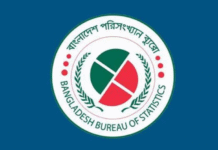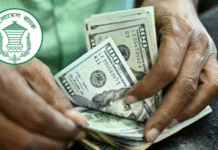While income has increased in the country, revenue collection hasn’t increased in that proportion. This is a strange economy, where there is high GDP growth but revenue collection doesn’t increase. The revenue ratio with the GDP remains stuck below 10 per cent, the lowest in the region. On the other hand, despite efforts, government expenditure isn’t going above 13 to 14 per cent. Generally speaking, collection is low, expenditure is low too. So it is unrealistic to be so agitated over apprehensions of budget deficit. The budget deficit that happens, remains within 5 or 5.5 per cent of the GDP.
What needs to be noted is how the funding is taking place. It is always said in the budget that the deficit is mostly funded from overseas sources. But at the end of the day, actually most of the funds come from domestic sources. One year more Sanchay Patra (Savings Certificates) are sold to bring in more money, the next year money is procured from the banking system. This still prevails. The government takes huge loans from the banking system, the banks have uncertain investments in the share market and huge amounts of loans remain in default, as the banks suffer from a liquidity crisis. All in all, the financial sector too is weakening further in the 2021-22 financial year.
This situation hasn’t been caused by Covid alone. One of the main reasons is that the reforms that were required in the revenue and financial sectors were not carried out. So while NBR has the ambitions, it does not have the technical preparation.
Two areas of expenditure are coming forward in the revenue budget this time. One is subsidy, transfer, stimulus and such, and the other is repayment of the loan dues, particularly repayment of interest on the domestic loans. All this is necessitating huge additional allocations in the revised budget. The full picture hasn’t emerged clearly as yet, but around 55 per cent of the revenue budget will be spent on subsidy and interest. The government can’t drop salaries and allowances. So after spending on salaries, allowances and these three areas, the government will have very little revenue surplus left over.
For these reasons it has become difficult to arrange funds from domestic sources for the Annual Development Programme (ADP). This time the ADP implementation rate is lower than any other year. Necessary fund allocation isn’t made for the project in the ADP and then again, there are no proper technical or feasibility studies carried out at the start of these projects. And when the projects are over, there is no assessment of what how these have benefitted the target groups. Just an account of the expenditure is taken, and less importance is given to the results. So, generally speaking, there is hardly much improvement in expenditure either.
But the government is talking about an expansionary large budget.
An expansionary fiscal policy is required now to stimulate the economy. But even if the government wants this income and expenditure situation, it will not effectively be able to come up with an expansionary budget. It has neither any large financial resources nor the required managerial skills. Talking about an expansionary budget is nothing but rhetoric, not reality. The government is taking a 500 million dollar loan from the World Bank to increase its funds, but there question remains whether the government will be able to ensure qualitative expenditure of these funds and within the stipulated time.
Certain indicators of the economy are now under fresh pressure, particularly in certain international indexes.
Global transactions were a strong area of our economy, but now even that area is showing cracks. We talk about good increase in exports, but that is not correct. Exports have gone by 33 per cent in the country, but on the other hand, imports have increased by 51 per cent. And the garment sector is surviving on the volume of exports, not on the price of the products. And the medium trends in remittance will fall further. It is true that there will be ups and down during Eid, Covid and the election, but given the prevailing global circumstances, remittances will remain instable in all likelihood.
Meanwhile, the net flow of Foreign Direct Investment (FDI) is simply not exceeding 1 billion dollars. While taking foreign loans has increased, this has less cost-effective assistance. The indicator of worst foreign transactions is the current account balance, which means the capital and financial transactions with overseas quarters.
The 2020-21 fiscal ended with a 3.8 billion dollar deficit in the current account. This is now within a 10 billion dollar deficit. And if we look at the deficit in foreign transactions, last fiscal there was a 9 billion dollar surplus, but now that has become negative 2 billion dollars.
What I want to say is that the country’s financial sector was rather shaky and now the weakness in the foreign sector has been added to this. Then again there is the pressure of inflation. Inflation hasn’t increased simply because prices in the international market have gone up. There is also the effect of the taka steadily weakening. In other countries, inflation arose because the government was spending more. That is, because of an expanding funds. The difference between Bangladesh and other countries is that in the post-Covid economic situation, they are decreasing government expenditure meaning they decreasing cash flow in the market. But we didn’t make any big government expenditure.
If inflation increases now, if there is a decrease in the taka exchange rate, the government will have no alternative but to increase interest rates. This may have a negative impact on private investments, though I do not think private investment in Bangladesh will be held up simply due to interest rates. There are multiple other reasons for this. But it is true that there are no signs of private investment picking up. From January this year the credit flow in the private sector has begun to fall again and is much lower than the target declared in Bangladesh Bank’s monetary policy.
How do you view the government efforts? It is doing a lot of good work too.
While the government’s policy initiatives are good, these come quite late and inadequately. We have long been talking about duty adjustment, simplifying imports, increasing subsidy, expanding reach of TCB and widening social safety nets in order to enable the suffering people maintain their living standards amid this inflation. The government has done this to a great extent, but quite late and not adequately.
The government cannot act on time due to structural inefficiencies. There is a lack of data and information. Along with information anarchy, there is also information blindness. This lack of information hampers the government from taking timely action and has an almost opposite impact. For example, we calculate inflation on the basis of 17-year-old consumption models which has nothing to do with the market.
What about the government’s plans to provide 10 million families with food assistance?
The government is speaking about feeding 10 million families. How will these 10 million families be specified? During the pandemic, the government had decided to provide assistance to 5 million people, but due to lack of data, could not provide this support to more than 3.8 million. A list of 10 million people was supposed to have been prepared and published. It was said this would be done a week before Ramadan. A week of Ramadan has passed and we are still unclear about the situation.
Also, will the list of those to receive assistance be posted up in public? After all, in the past the government has the intention to provide the assistance, but there was confusion, corruption and discrimination in the distribution. So misgivings linger about the government’s announcement of assistance for 10 million families.
So what’s the bottom line?
On one hand the government has to increase its overall expenditure, particularly in the sectors of education, health and social safety for all, and this must be qualitative expenditure. And the suffering people must be specifically targeted and directly given cash and food assistance. The problem is that the government does not have the necessary institutional, administrative and political skills to carry this out in an accountable manner based on facts and figures.
The reason behind this lacking is that after 2013-14 there has been no major reforms in the financial sector. The government’s problem of not being able to increase income and expenditure, is of its own making. As the old problems have not been resolved, the government finds itself hostage to this old problems when trying to address the new ones.
We achieved great success in using IT for procuring, distributing and administering Covid vaccines. The question is, is the limitations we see in the government’s capacity for income and expenditure a matter of political disinterest or lack of initiative?










